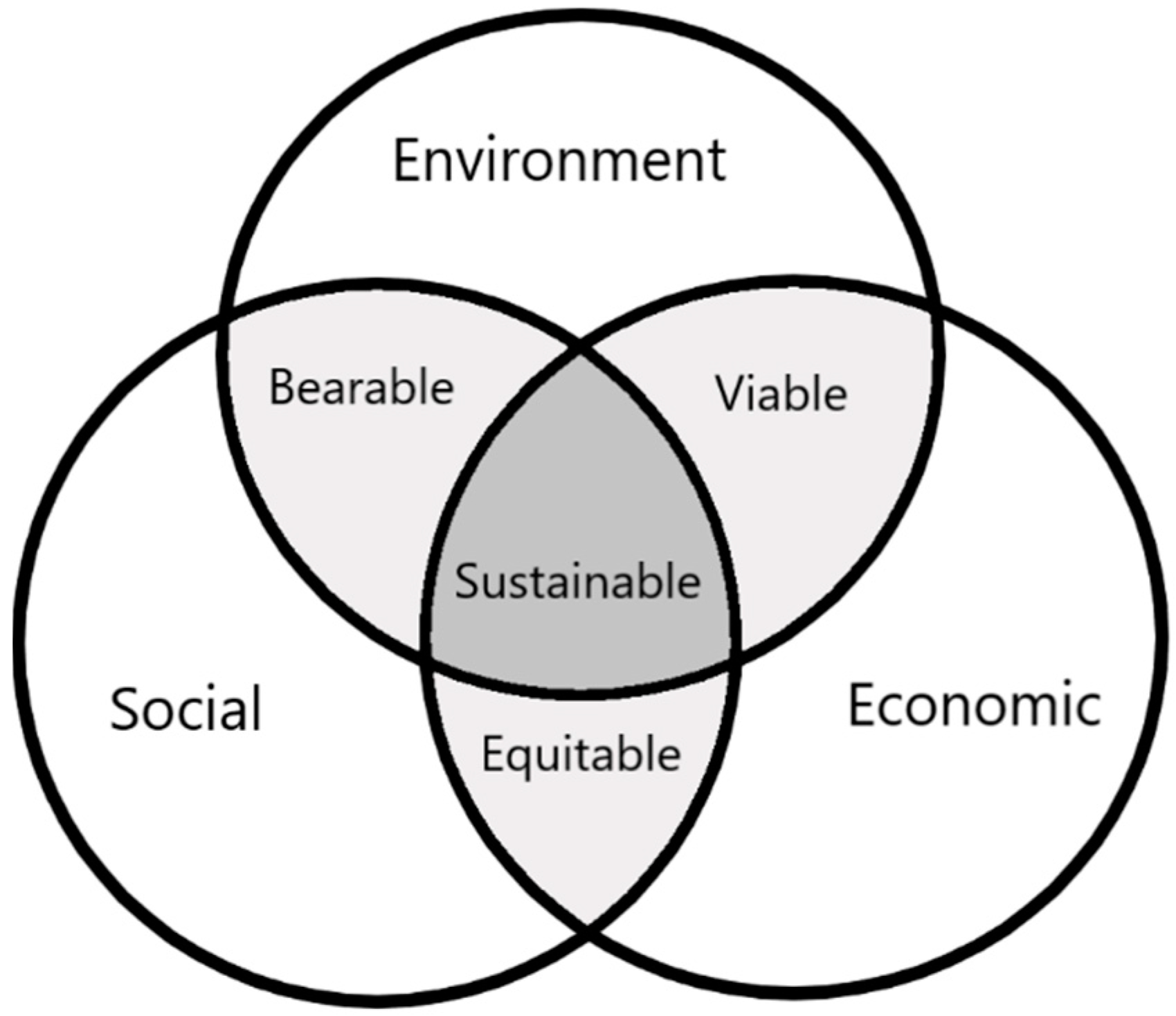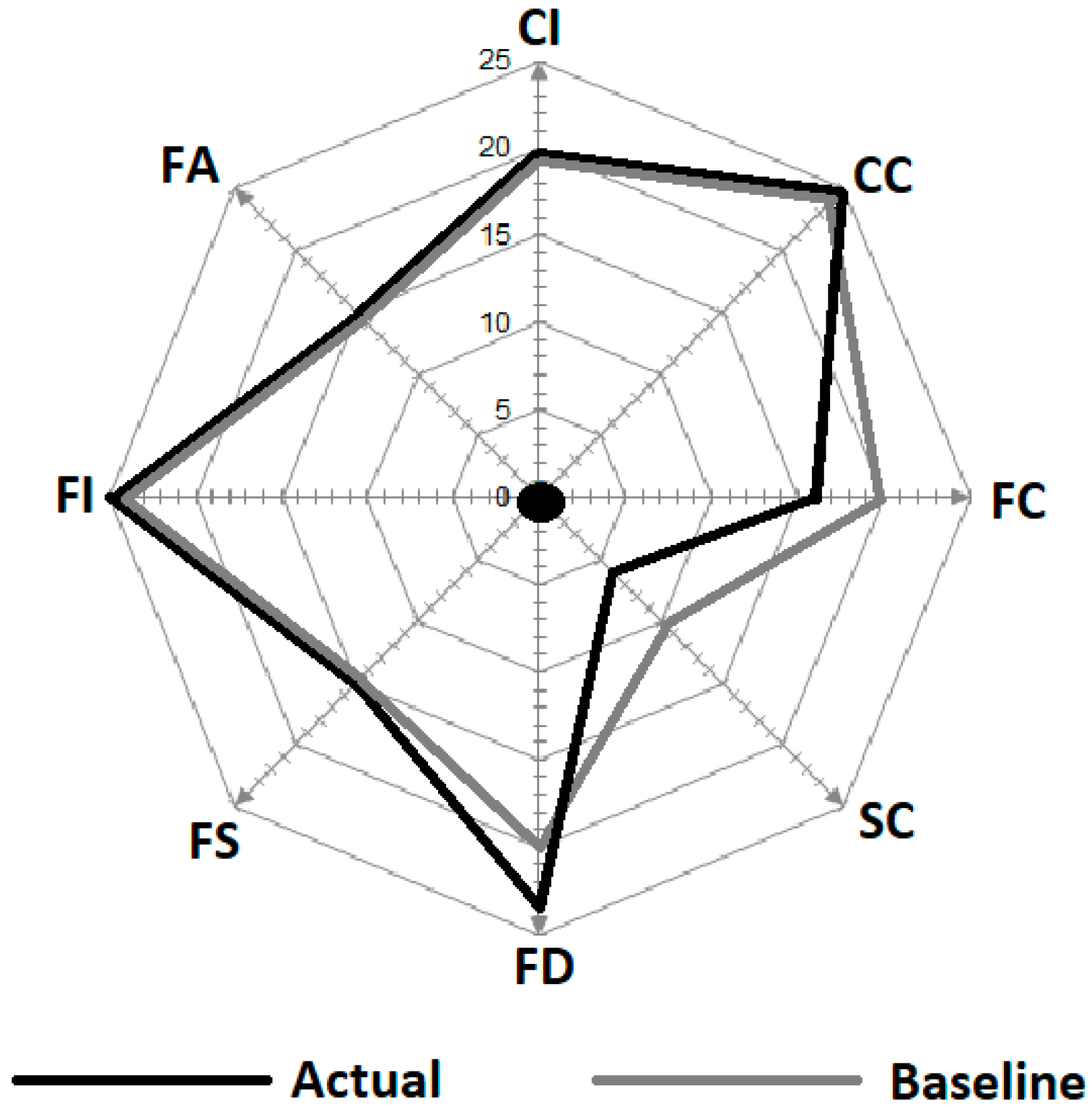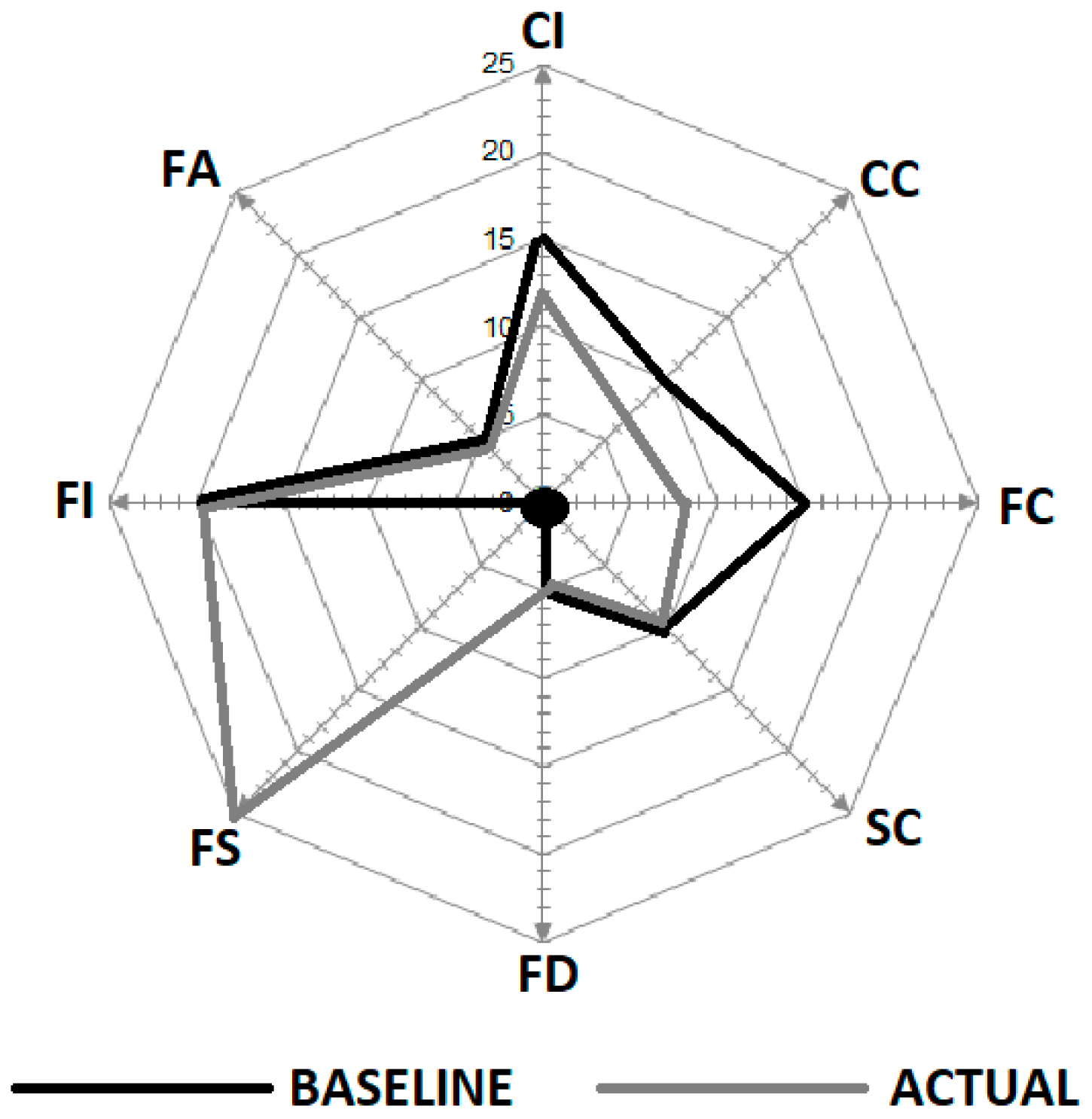Risk Index Method–A Tool for Sustainable, Holistic Building Fire Strategies
Abstract
1. Introduction
1.1. The Mismatch between Sustainability and Fire Engineering
1.2. The Development of Performance-Based Fire Engineering
- It provided the designer with a disciplined approach to fire safety design;
- It allowed the safety levels of alternative designs to be compared;
- Iit provided a basis for selection of appropriate fire protection systems;
- It provided opportunities for innovative design;
- It provided information on the management of fire safety for a building.
1.3. The Sustainability Issue in Fire Safety Standardisation
1.4. Issues Surrounding the Reality of the Application of A Performance-Based Approach
1.5. An Introduction to Holistic Fire Strategies
- (a)
- Provide a highly auditable framework. The key beneficiaries of this will be enforcement agencies around the world, which will enjoy increased confidence in HFS-based fire strategies. They will also benefit by reducing the currently high levels of resource and time commitment required to evaluate each submitted strategy.
- (b)
- Provide a consistent approach and format, whether the building design is based in London, Stockholm, Chicago, Dubai, Sydney, etc. The idea here is to introduce a fire strategy framework for each building and occupancy type. This is referred to as a metric template. The concept is that a metric template is prepared for each building type such as airport, hospital, office block, etc. This template would formalize the approach taken and guide the person preparing the strategy to consider premises related issues. The template would be peer reviewed by local authorities in the field for each type of metric template.
- (c)
- Widen the scope of fire strategies to include threat assessment and objectives setting. This will be part of the metric template process.
2. Fire Strategy Evaluation Methodology
2.1. Introduction
- Scoring of eight separate fire safety factors;
- Presentation of the results at the fire strategy value grid;
- Calculation of the fire strategy risk index (FRI), which is used as the final factor for evaluation.
2.2. Preparation of an Eight-Part Questionnaire
2.3. Fire Strategy Risk Index Calculation
2.4. Introducing a Weighting System
- -
- The requirements and guidance of national legislation and codes.
- -
- The results of objectives setting and threat analysis.
- -
- Building-specific issues that one or more stakeholders deem important.
3. Worked Examples
3.1. Metro Station
3.2. School Building
- Some irregular requirements for testing of electrical equipment (CI).
- Some of the linings specified were found to be not fire resistant (CC).
- Non-resistant glazing was specified for incorporation into some of the fire resisting partitions (FC).
- A sprinkler system had been fitted throughout on the advice of the local authority (FS).
4. Conclusions
Author Contributions
Funding
Conflicts of Interest
References
- Collins English Dictionary Online. 2020. Available online: https://www.collinsdictionary.com (accessed on 10 March 2020).
- Ziemba, J. Sustainable Fire Protection: Charting a New Course. Fire Safety. 2019. Available online: https://www.firesafetysearch.com/sustainable-fire-protection/ (accessed on 10 March 2020).
- Troisi, R.; Alfano, G. Towns as Safety Organizational Fields: An Institutional Framework in Times of Emergency. Sustainability 2019, 11, 7025. [Google Scholar] [CrossRef]
- British Standard. BS 5588-1, 1990, Fire Precautions in the Design, Construction and Use of Buildings. Code of Practice for Residential Buildings (Withdrawn); The British Standards Institution: London, UK, 1990. [Google Scholar]
- The National Fire Protection Association. SFPE Engineering Guide to Performance-Based Fire Protection, 2nd ed.; The National Fire Protection Association: Quincy, MA, USA, 2007. [Google Scholar]
- Al-Janabi, M.; Thomas, G.; Donn, M. Sustainable Building Features And Fire Safety. In Proceedings of the Conference: Building A Better New Zealand, Auckland, New Zealand, 3–5 September 2014; Available online: https://www.researchgate.net/publication/273123862_Sustainable_Building_Features_And_Fire_Safety (accessed on 10 March 2020).
- Brzezinska, D. Origins and Development of Fire Safety Engineering in Poland. BiTP 2016, 42, 141–149. [Google Scholar] [CrossRef]
- Hurley, M. (Ed.) SFPE Handbook of Fire Protection Engineering, 5th ed.; Springer: New York, NY, USA, 2016. [Google Scholar]
- Meacham, B. An Holistic Framework for Risk-Informed Performance-Based Building Regulation. In Proceedings of the 15th International Conference on Fire Science and Engineering, Interflam 2019, Royal Holloway College—University of London, London, UK, 1–3 July 2019. [Google Scholar]
- Dent, S. Fire Protection Engineering and Sustainable Design. Fire Prot. Eng. 2010, 46, 10–16. Available online: https://www.sfpe.org/page/2010_Q2_1 (accessed on 10 March 2020).
- Snyder, L. Green Building Design Can Pose Fire Safety Challenges. Facilitiesnet. 30 November 2010. Available online: https://www.facilitiesnet.com/firesafety/article/Green-Building-Design-Can-Pose-Fire-Safety-Challenges--12129 (accessed on 10 March 2020).
- Vecchiarelli, T. Fire Safety in a Sustainable World. NFPA. 1 January 2014. Available online: https://www.nfpa.org/News-and-Research/Resources/Emergency-Responders/Job-tools-and-resources/NFPA-and-sustainability/Fire-safety-in-a-sustainable-world (accessed on 1 January 2014).
- British Standard. BS 9999, 2017, Fire Safety in the Design, Management and Use of Buildings. Code of Practice; The British Standards Institution: London, UK, 2017. [Google Scholar]
- British Standard. BS 7974, 2019, Application of Fire Safety Engineering Principles to the Design of Buildings. Code of Practice; The British Standards Institution: London, UK, 2019. [Google Scholar]
- British Standard. DD 240-1, 1997, Fire Safety Engineering in Buildings. Guide to the Application of Fire Safety Engineering Principles (Withdrawn); The British Standards Institution: London, UK, 1997. [Google Scholar]
- British Standard. PD 7974-0, 2002, Guide to Design Framework and Fire Safety Engineering Procedures; The British Standards Institution: London, UK, 2002. [Google Scholar]
- British Standard. PD 7974-1, 2019, Application of Fire Safety Engineering Principles to the Design of Buildings. Initiation and Development of Fire within the Enclosure of Origin; The British Standards Institution: London, UK, 2019. [Google Scholar]
- British Standard. PD 7974-2, 2019, Application of Fire Safety Engineering Principles to the Design of Buildings. Spread of Smoke and Toxic Gases within and beyond the Enclosure of Origin; The British Standards Institution: London, UK, 2019. [Google Scholar]
- British Standard. PD 7974-3, 2019, Application of Fire Safety Engineering Principles to the Design of Buildings. Structural Response and Fire Spread Beyond the Enclosure of Origin; The British Standards Institution: London, UK, 2019. [Google Scholar]
- British Standard. PD 7974-4, 2003, Application of Fire Safety Engineering Principles to the Design of Buildings. Detection of Fire and Activation of Fire Protection Systems; The British Standards Institution: London, UK, 2003. [Google Scholar]
- British Standard. PD 7974-5, 2019, Application of Fire Safety Engineering Principles to the Design of Buildings. Fire and Rescue Service Intervention; The British Standards Institution: London, UK, 2019. [Google Scholar]
- British Standard. PD 7974-6, 2019, Application of Fire Safety Engineering Principles to the Design of Buildings. Human Factors. Life Safety Strategies. Occupant Evacuation, Behaviour and Condition; The British Standards Institution: London, UK, 2019. [Google Scholar]
- British Standard. PD 7974-7, 2019, Application of Fire Safety Engineering Principles to the Design of Buildings. Probabilistic Risk Assessment; The British Standards Institution: London, UK, 2019. [Google Scholar]
- British Standard. PD 7974-8, 2012, Application of Fire Safety Engineering Principles to the Design of Buildings. Property Protection, Business and Mission Continuity, and Resilience; The British Standards Institution: London, UK, 2012. [Google Scholar]
- The UK Building Regulations. Approved Document B (Fire Safety)—Volume 1: Dwelling Houses (2006 Edition Incorporating 2010 and 2013 Amendments); The UK Building Regulations: Norwich, UK, 2010. [Google Scholar]
- The UK Building Regulations. Approved Document B (Fire Safety)—Volume 2: Buildings Other than Dwelling Houses (2006 Edition Incorporating 2010 and 2013 Amendments); The UK Building Regulations: Norwich, UK, 2010. [Google Scholar]
- National Fire Protection Association. NFPA 101A, 2018, Guide on Alternative Approaches to Life Safety; National Fire Protection Association: Quincy, MA, USA, 2018. [Google Scholar]
- National Fire Protection Association. NFPA 101, 2019, Life Safety Code; National Fire Protection Association: Quincy, MA, USA, 2019. [Google Scholar]
- New Zealand Building Code. Clauses C1-C6 Protection from Fire, C/VM2 Verification Method: Framework for Fire Safety Design; The Ministry of Business, Innovation and Employment: Wellington, New Zealand, 2014. [Google Scholar]
- The Ministry of Business, Innovation and Employment. UAE Fire and Life Safety Code of Practice—DCD; The Ministry of Business, Innovation and Employment: Wellington, New Zealand, 2018.
- Messerschmidt, B.; Lamont, S. Fire Risk Assessment of High Rise Buildings With Combustible Exterior Wall Assemblies: NFPA’s EFFECT® Tool. In Proceedings of the 15th International Conference on Fire Science and Engineering, Interflam 2019, Royal Holloway College–University of London, London, UK, 1–3 July 2019. [Google Scholar]
- Pilkington Glass. 2020. Available online: https://www.pilkington.com/en-gb/uk/architects/glass-information/glassandtheenvironment/fire-and-sustainability (accessed on 10 May 2020).
- MPE Web Site. 2012. Available online: http://mpe.dimacs.rutgers.edu/images/sustainability-chart/ (accessed on 10 March 2020).
- British Standard. PAS 911, 2007, Fire Strategies—Guidance And Framework For. Their Formulation; The British Standards Institution: London, UK, 2007. [Google Scholar]
- Schoonmaker, R. Green Buildings and Sustainable Fire Safety Technology—Moving Ahead. PCI. 4 September 2019. Available online: https://www.pcimag.com/articles/106512-green-buildings-and-sustainable-fire-safety-technology-moving-ahead (accessed on 4 September 2019).
- Bryant, P. Fire Strategies—Strategic Thinking; Kingfell: London, UK, 2013; p. 186. [Google Scholar]
- Albrech, C. Quantifying life safety Part II: Quantification of fire protection systems. Fire Saf. J. 2014, 64, 81–86. [Google Scholar] [CrossRef]
- Park, H.; Meacham, B.; Dembsey, N.; Goulthorpe, M. Conceptual Model Development for Holistic Building Fire Safety Performance Analysis. Fire Technol. 2015, 51, 173–193. [Google Scholar] [CrossRef]
- Van Hees, P.; Stromgren, M.; Meacham, B. An Holistic Approach for Fire Safety Requirements and Design of Facade Systems. In Proceedings of the 15th International Conference on Fire Science and Engineering, Interflam 2019, Royal Holloway College—University of London, London, UK, 1–3 July 2019. [Google Scholar]
- Gretener, M. Evaluation of Fire Hazard. and Determining Protective Measures; Association of Cantonal institutions for Fire Insurance (VKF) and Fire Prevention Service for Industry and Trade (BVD): Zurich, Switzerland, 1973. [Google Scholar]
- Watts, J.M., Jr. Fire Risk Indexing. In SFPE Handbook of Fire Protection Engineering; Hurley, M.J., Ed.; Society of Fire Protection Engineers/Springer: New York, NY, USA, 2016; pp. 3158–3182. [Google Scholar] [CrossRef]
- Brzezinska, D.; Bryant, P. Buildings Fire Protection Strategies; Lodz University of Technology: Lodz, Poland, 2018; p. 209. [Google Scholar]
- Brzezinska, D.; Bryant, P. New Anglo-Polish Methodology for Fire Strategies Evaluation. In Proceedings of the 15th International Conference on Fire Science and Engineering, Interflam 2019, Royal Holloway College—University of London, London, UK, 1–3 July 2019. [Google Scholar]
- Brzezinska, D.; Bryant, P.; Markowski, A. An Alternative Evaluation and Indicating Methodology for Sustainable Fire Safety in the Process Industry. Sustainability 2019, 11, 4693. [Google Scholar] [CrossRef]
- De Smet, E. Fire Risk Assessment Method for Engineering—FRAME. 2008. Available online: http://www.framemethod.net/ (accessed on 20 May 2019).
- Hasofer, A.M.; Thomas, I.R. Cost Benefit Analysis of a Fire Safety System Based on the Life Quality Index. Fire Saf. Sci. 2008, 9, 969–980. [Google Scholar] [CrossRef]
- UK Government. Top-Tips-for-Sustainability-in-Schools; Department for Education: London, UK, 2012. Available online: https://www.gov.uk/government/publications/top-tips-for-sustainability-in-schools (accessed on 10 March 2020).




| Node | Questionnaire | Max Score |
|---|---|---|
| 1 Control of ignition sources (CI) | Basic management documented controls (≤5) + regular testing of electrical systems (≤5) + restriction of all forms of ignition to protected and fire separated areas (≤10) + specialised ignition control methods (≤5) | 25 |
| 2 Control of combustibles (CC) | Basic management documented controls (≤5) + strict controls on specification of internal and external building fascia’s and linings (≤5) + strict controls on the specification of fixtures, fittings and equipment (≤5) + restricted allowances on size, location and/or type of combustible materials in common spaces (≤5) + creation of sterile areas in escape routes by locating combustible materials in controlled and contained environments (≤5) | 25 |
| 3 Fire Compart-mentation (FC) | Requirements for structural integrity of the building against fire (≤5) + fire separation of escape routes from risk areas (≤5) + enhanced fire separation to allow for firefighting operations (≤5) + enhanced fire separations to maintain specific occupied areas of the building until firefighting operations have been completed (≤5) + enhanced fire separations to allow for protection of assets (≤5) | 25 |
| 4 Smoke Control Systems (SC) | Use of simple methods to vent key areas (e.g., opening of windows in escape stairs and lobbies) (≤5) OR automatically operating proprietary venting arrangements (≤10) + mechanical smoke extract or pressurization systems in escape staircases (≤5) + mechanical smoke extract systems to enable variations of other elements of the fire strategy (e.g., extended travel distances) (≤5) + use of smoke control systems to allow continuance of critical operations during a fire incident (≤5) | 25 |
| 5 Fire Detection (FD) | An automatic fire alarm system using manual activation only (≤5) + monitoring escape routes by fire detectors (≤5) + monitoring of hazard areas (≤5) + monitoring all remaining areas (≤5) + enhanced specialist monitoring methods (≤5) | 25 |
| 6 Fire Suppression (FS) | Suppression systems to protect high hazard equipment (≤5) + systems to protect hazard rooms or areas (≤5) + systems to protect key parts of the building (≤5) + systems to protect all remaining areas of the building (≤10) | 25 |
| 7 Fire service intervention (FI) | Manual method only for contacting fire service (≤5) OR automatic or 24/7 trained manual contact (≤10) + response time to be within national guidance (≤5) + proprietary facilities for access to all parts of the building (≤5) + facilities for firefighting water supplies (≤5) | 25 |
| 8 First aid Firefighting (FA) | Provision of portable fire extinguishers (≤5) + personnel trained in their use (≤5) + specialist firefighting systems for specific risks (≤5) + trained professional firefighters on-site for rapid attendance to a fire (≤10) | 25 |
| Node | W | Baseline | Actual |
|---|---|---|---|
| 1 Control of ignition sources (CI) | 0.1 | 20 | 20 |
| 2 Control of combustibles (CC) | 0.1 | 25 | 25 |
| 3 Fire Compartmentation (FC) | 0.1 | 20 | 16 |
| 4 Smoke Control Systems (SC) | 0.1 | 10 | 6 |
| 5 Fire Detection (FD) | 0.3 | 20 | 24 |
| 6 Fire Suppression (FS) | 0.1 | 15 | 15 |
| 7 Fire service intervention (FI) | 0.1 | 25 | 25 |
| 8 First aid firefighting (FA) | 0.1 | 15 | 15 |
| Node | W | Baseline | Actual |
|---|---|---|---|
| 1 Control of ignition sources (CI) | 0.125 | 15 | 12 |
| 2 Control of combustibles (CC) | 0.05 | 10 | 7 |
| 3 Fire Compartmentation (FC) | 0.125 | 15 | 8 |
| 4 Smoke Control Systems (SC) | 0.125 | 10 | 10 |
| 5 Fire Detection (FD) | 0.125 | 5 | 5 |
| 6 Fire Suppression (FS) | 0.2 | 0 | 25 |
| 7 Fire service intervention (FI) | 0.125 | 20 | 20 |
| 8 First aid firefighting (FA) | 0.125 | 5 | 5 |
© 2020 by the authors. Licensee MDPI, Basel, Switzerland. This article is an open access article distributed under the terms and conditions of the Creative Commons Attribution (CC BY) license (http://creativecommons.org/licenses/by/4.0/).
Share and Cite
Brzezińska, D.; Bryant, P. Risk Index Method–A Tool for Sustainable, Holistic Building Fire Strategies. Sustainability 2020, 12, 4469. https://doi.org/10.3390/su12114469
Brzezińska D, Bryant P. Risk Index Method–A Tool for Sustainable, Holistic Building Fire Strategies. Sustainability. 2020; 12(11):4469. https://doi.org/10.3390/su12114469
Chicago/Turabian StyleBrzezińska, Dorota, and Paul Bryant. 2020. "Risk Index Method–A Tool for Sustainable, Holistic Building Fire Strategies" Sustainability 12, no. 11: 4469. https://doi.org/10.3390/su12114469
APA StyleBrzezińska, D., & Bryant, P. (2020). Risk Index Method–A Tool for Sustainable, Holistic Building Fire Strategies. Sustainability, 12(11), 4469. https://doi.org/10.3390/su12114469





